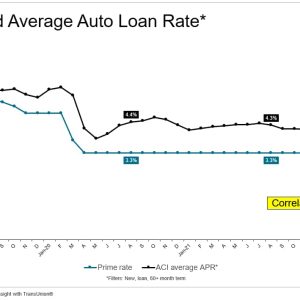
Credit Union Rates Fall Below Banks and Captives
The Federal Reserve Banks current rate increases to curb
inflation have actually rapidly cascaded to the retail US auto industry. In
reality, as shown below, average loan rates began climbing prior to the
prime rate went up. Back in January, the average loan rate
increased.2 PP month-over-month to 4.3%, and it has actually been rising
since, reaching 5.6% in July. Also, the concurrent boosts
in the prime rate and the typical auto loan rate must not be
unexpected: the correlation coefficient in between the two metrics is
an extremely strong.95. Nevertheless, these rate increases have actually differed depending on the
purchasers credit standing. While the most credit-worthy customers
( 781 – 850) have actually seen rates more than double from May 2020 to 4.4%.
this previous August, households with the least expensive credit report.
( 300-600) have actually seen a. 1 PP rate decrease to.
10.6%. This lower tier of consumers, though, still are paying a.
rate more than double that of the leading tier.Auto loan rates likewise vary depending on the lending institution type.
Independents (5% of the loan company August 2022 CYTD).
regularly have actually been charging considerably greater rates than the.
other types, and independents rates have actually been stable because early.
this year. Banks (32%) and slaves (35%), on the other hand, have.
been raising rates considering that January.Credit union (29%) rates, comparable to bank and slave rates from.
January 2019 through the end of in 2015, have actually not risen this year.
in the exact same way as bank and hostage rates. As an outcome, credit.
unions now use the most affordable average rates in the industry,.
including 4.7% in August versus 5.4% for hostages and 6.2% for.
banks. Without the requirement to concentrate on revenues, credit unions can pass.
on any internal surpluses to their customers via lower rates. Numerous.
cooperative credit union also do not pay federal taxes, another factor for.
their lower rates.
—————————————————————————————————- Top 10 Industry Trends ReportThis vehicle insight is part of our regular monthly Top 10.
Industry Trends Report. The report findings are drawn from.
brand-new and used registration and loyalty data.The October report is now readily available, including August 2022.
CFI and LAT information. To download the report, please click below.DOWNLOAD REPORT.
Posted 31 October 2022 by Tom Libby, Associate Director, Loyalty Solutions and Industry Analysis, S&P Global Mobility.
This article was published by S&P Global Mobility and not by S&P Global Ratings, which is an independently managed division of S&P Global.
Leave a reply